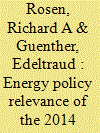|
|
|
Sort Order |
|
|
|
Items / Page
|
|
|
|
|
|
|
| Srl | Item |
| 1 |
ID:
150913


|
|
|
|
|
| Summary/Abstract |
World population is projected to reach 10.9 billion by 2100, yet nearly one-fifth of the world's current 7.2 billion live without access to electricity. Though universal energy access is desirable, a significant reduction in fossil fuel usage is required before mid-century if global warming is to be limited to <2 °C. Here we quantify the changes in the global energy mix necessary to address population and climate change under two energy-use scenarios, finding that renewable energy production (9% in 2014) must comprise 87–94% of global energy consumption by 2100. Our study suggests >50% renewable energy needs to occur by 2028 in a <2 °C warming scenario, but not until 2054 in an unconstrained energy use scenario. Given the required rate and magnitude of this transition to renewable energy, it is unlikely that the <2 °C goal can be met. Focus should be placed on expanding renewable energy as quickly as possible in order to limit warming to 2.5–3 °C.
|
|
|
|
|
|
|
|
|
|
|
|
|
|
|
|
| 2 |
ID:
150926


|
|
|
|
|
| Summary/Abstract |
Existing policies of household biogas projects focus mainly on supports on construction, but less consider management and maintenance, resulting in high scrap rate and waste of resources. Alternative policies must be explored to balance construction and operation. Taking the costs and benefits from a typical rural household biogas project, this paper assesses the economic performance at three different subsidy levels, i.e., no subsidy, existing standard and positive externality based standard. Furthermore three subsidy alternatives, one-time, annual and combined option are applied to the externality based standard. The results show that household biogas digesters have unsatisfactory economic performance without any subsidy and even in current subsidy policies. Environmental benefits of the digester were estimated as 2732 Chinese Yuan, significantly larger than existing subsidy standard. To keep continuous work during the 20-year lifespans of digesters, the income disparity of farmers among regions must be considered for policy application. With the increasing of labor costs, the ratio of initial subsidies must be reduced. These results provide policy implications to the future development of biogas projects in terms of both their construction and follow-up management, reuse of the abandoned digesters as well as the exploitation of other emerging renewable energy projects.
|
|
|
|
|
|
|
|
|
|
|
|
|
|
|
|
| 3 |
ID:
150904


|
|
|
|
|
| Summary/Abstract |
Peak reduction is an important problem in the context of the electricity grid and has led to conservation programs in various jurisdictions. For example, in Ontario, Canada, residential customers are charged higher prices during peak times, while large industrial and commercial customers pay heavy surcharges that depend on their load during Ontario’s five peak-demand days. Reducing these surcharges is a challenging problem for large consumers due to the difficulty of predicting peak days in advance.
We study the impact of this peak reduction program, called 5 Coincident Peaks (5CP), on consumers by analyzing the difficulty of predicting peak-demand days and peak hours on those days. We find that even the state-of-the art peak-prediction algorithms require consumers to curtail load ten or more times, and even then, they may not identify all five peak-demand days. We also analyze alternative policies that cold help reduce peak demand in Ontario.
|
|
|
|
|
|
|
|
|
|
|
|
|
|
|
|
| 4 |
ID:
150899


|
|
|
|
|
| Summary/Abstract |
Subsidizing energy-efficient technologies is considered by energy and environmental organizations to be one of the most effective policies for decreasing energy consumption. In the transportation sector such policies are becoming ever more popular, and have been implemented in a considerable number of countries in recent years. Because these policies promote energy-efficient cars with lower usage costs, they may rebound and increase the distances traveled by households that have switched to energy-efficient cars. From an econometric perspective, a subsidization policy can be used as a valid instrument to identify the households’ choice of energy efficiency levels of the cars they own. This identification, in turn, can be utilized to account for endogeneity in the estimation of a rebound effect. The present study uses a natural experiment setting of such a policy implemented in Israel in 2009. The empirical results indicate a fairly large average rebound effect of 40%. The results also indicate that while the policy indeed encouraged the purchase of energy-efficient cars, households that bought a new or used car during the surveyed period did not generate a rebound effect of a different magnitude compared with other households that did not. We discuss the implications of our findings.
|
|
|
|
|
|
|
|
|
|
|
|
|
|
|
|
| 5 |
ID:
150895


|
|
|
|
|
| Summary/Abstract |
Fossil fuels face resource depletion, supply security, and climate change problems; renewable energy (RE) may offer the best prospects for their long-term replacement. However, RE sources differ in many important ways from fossil fuels, particularly in that they are energy flows rather than stocks. The most important RE sources, wind and solar energy, are also intermittent, necessitating major energy storage as these sources increase their share of total energy supply. We show that estimates for the technical potential of RE vary by two orders of magnitude, and argue that values at the lower end of the range must be seriously considered, both because their energy return on energy invested falls, and environmental costs rise, with cumulative output. Finally, most future RE output will be electric, necessitating radical reconfiguration of existing grids to function with intermittent RE.
|
|
|
|
|
|
|
|
|
|
|
|
|
|
|
|
| 6 |
ID:
150914


|
|
|
|
|
| Summary/Abstract |
In this article we conceptualise energy use from a capabilities perspective, informed by the work of Amartya Sen, Martha Nussbaum and others following them. Building on this, we suggest a corresponding definition of energy poverty, as understood in the capabilities space. We argue that such an understanding provides a theoretically coherent means of comprehending the relationship between energy and wellbeing, and thus conceptualising energy deprivation, that makes sense across settings including both the global North and South: a coherence which has previously been lacking. At the same time, it has the flexibility to be deployed in a way that is sensitive to local contexts. Understanding energy use in the capabilities space also provides a means for identifying multiple sites of intervention, including some areas that are currently largely overlooked. We argue that this is advantageous for attempts to address energy poverty in the context of climate change and imperatives for the containment of aggregate energy consumption.
|
|
|
|
|
|
|
|
|
|
|
|
|
|
|
|
| 7 |
ID:
150910


|
|
|
|
|
| Summary/Abstract |
More than 20% of the electricity generated in India is lost to rampant thefts. Drawing data from 28 states of India over a time span of five years (2005–2009), this paper examines the role played by socio-economic and governance factors in determining the extent of electricity thefts in Indian states. Results from the Feasible Generalised Least Squares (FGLS) model demonstrate that lesser corruption, higher state tax to GDP ratio, greater collection efficiency of electricity bills by state utilities, higher share of private installed capacity, lesser poverty, greater literacy and greater income are closely associated with lesser power thefts. A better understanding of the key determinants of thefts in electricity distribution is vital for policy makers for designing policies.
|
|
|
|
|
|
|
|
|
|
|
|
|
|
|
|
| 8 |
ID:
150923


|
|
|
|
|
| Summary/Abstract |
This study investigates the effect of renewable energy production on water and land footprint in 58 developed and developing countries for the period of 1980–2009. Utilizing the ecological footprint as an indicator, the fixed effects, difference and system generalized method of moment (GMM) approaches were employed and eight different models were constructed to achieve robustness in the empirical outcomes. Despite the use of different methods and models, the outcome was the same whereby GDP growth, urbanization, and trade openness increase the water and land footprint. Moreover, renewable energy production increases the water and land inefficiency because of its positive effect on ecological footprint. Additionally, based on the square of GDP it is concluded that the EKC hypothesis does not exist while the square of renewable energy production indicates that renewable energy production will continue to increase water and land footprint in the future. From the outcome of this study, a number of recommendations were provided to the investigated countries.
|
|
|
|
|
|
|
|
|
|
|
|
|
|
|
|
| 9 |
ID:
150911


|
|
|
|
|
| Summary/Abstract |
A majority of grid-connected households in South Africa use electricity for cooking and heating tasks. This thermal intensive use of electricity has a high load factor and is a contributory factor of electricity demand outstripping supply at peak demand periods. The government has promoted liquefied petroleum gas (LPG) as an alternative thermal energy source for household cooking and heating. This study evaluates the long-term successes, challenges and social impacts of an LPG intervention project that was piloted in Atteridgeville Township, a typical low-income suburb. The data was gathered through one-on-one household interviews with a sample of the beneficiaries. The results indicate that seven years after the LPG intervention, about 70% of the beneficiaries continue to use LPG and report that the intervention has improved their welfare. Fast cooking is cited as the key tangible benefit of LPG technology in households, followed by saving on electricity bills. The project would have achieved more success through better community engagement, including strict beneficiary selection criteria; a long-term LPG distribution and maintenance plan; and inclusion of recurring monthly LPG subsidies for indigent households. The study discusses the subset of factors necessary for successful rollouts of similar energy projects.
|
|
|
|
|
|
|
|
|
|
|
|
|
|
|
|
| 10 |
ID:
150925


|
|
|
|
|
| Summary/Abstract |
This study models fundamental features of current and prospective policies encouraging adoption of residential photovoltaic (PV) systems. A key finding is that time-of-day (ToD) pricing can enhance or worsen the economics of PV systems. Moreover, increased responsiveness of electricity demand to its price diminishes the effectiveness of ToD pricing in the absence of net metering, but does not affect it otherwise. An application to plausible conditions in the State of Indiana, USA, shows that current policies are unlikely to trigger adoption by a risk-neutral forward-looking residential customer. However, adoption of PV systems can be induced if the Federal Tax Credit is increased to cover 48% of capital cost (instead of the current 30%), which could imply a cost to the Federal Government of about $0.95/kW of installed capacity depending on the panel’s size. We demonstrate that implementation of ToD pricing can trigger adoption under a range of on- and off-peak price combinations. But our analysis also shows that the cost-effectiveness of ToD pricing is enhanced at higher ratios of on-peak to off-peak prices.
|
|
|
|
|
|
|
|
|
|
|
|
|
|
|
|
| 11 |
ID:
150901


|
|
|
|
|
| Summary/Abstract |
This paper develops a model that explains the delay of decisions to adopt profitable energy-saving investments. This problem is known as the energy paradox. The model rationalizes the profitability requirements raised by the irreversibility, the uncertainty and the decrease of costs as a result of learning by doing. In this context, the wait gives investors more visibility and more lower investment costs, which gives them an option value. The representative agent has an interest to postpone its energy saving decision until future benefits increase and equalize its required option value. Formally, we internalize these explanatory factors in a stochastic model where the updated energy saving benefits follows a geometric Brownian motion. To affirm the capacity of the model, we generate simulation results for two equipments for electrical uses. Beyond that, we extend the model to simulate the effects of energy policy instruments to promote adoption of such equipments. Simulations prove that the taxation of energy prices is likely to be more effective than the subsidy for energy-saving equipments. It is also found that the combination of these instruments amplifies the adoption of energy-saving equipments and generates very favorable economic and environmental externalities.
|
|
|
|
|
|
|
|
|
|
|
|
|
|
|
|
| 12 |
ID:
150924


|
|
|
|
|
| Summary/Abstract |
Research which attempted to determine the macroeconomic importance of mitigating climate change through 2100 was presented primarily in Chapter 6 of the 2014 IPCC Working Group III report. Some of the findings of this chapter were then summarized in the Summary for Policy Makers (SPMs) of both the Synthesis Report, and the WGIII report. Unfortunately, these SPMs omitted key aspects of what the overall macroeconomic results for the costs and benefits of mitigating climate change actually did and did not include, how they were produced, and a careful assessment of their uncertainty and scientific validity. Yet, many of the major omissions were acknowledged deep in the text of Chapter 6, but were not revealed to the public. We conclude, therefore, that neither of these SPMs was useful for energy policy makers and energy managers, and they were misleading due to their many key omissions. Finally, we recommend several improvements that can be made to integrated assessment modeling methodologies so that the macroeconomic analysis of mitigating climate change resulting from the use of such models can be more relevant and useful to energy policy makers in the future, and can be communicated to them better.
|
|
|
|
|
|
|
|
|
|
|
|
|
|
|
|
| 13 |
ID:
150915


|
|
|
|
|
| Summary/Abstract |
Community-based renewable energy initiatives may be important actors in the transition toward low-carbon energy systems. In turn, stimulating investments in renewable energy production at the community level requires a better understanding of investors' motives. This paper aims to study the heterogeneity of motivations that drive individuals to participate in community renewable energy projects and the underlying explanatory factors behind this, as well as the implications for their level of engagement in initiatives. Based on quantitative data from an original survey conducted with two renewable energy cooperatives in Flanders, the statistical analysis shows that cooperative members should not be considered as one homogeneous group. Several categories of members with different motives and levels of engagement can be distinguished. This heterogeneity is explained by contrasts in terms of institutional settings, spatial patterns and attitudes to the diffusion of institutional innovations. Regarding policy implications, the findings suggest that this heterogeneity should be taken into account in designing more effective supporting policies to stimulate investments at the community level. The activation of social norms is also shown to be a promising mechanism for triggering investment decisions, although the implications of its interplay with economic incentives should be further explored.
|
|
|
|
|
|
|
|
|
|
|
|
|
|
|
|
| 14 |
ID:
150918


|
|
|
|
|
| Summary/Abstract |
The Covenant of Mayors (CoM) is an initiative of the European Commission started in 2008 with the aim of involving cities more in the implementation of the 20-20-20 climate-energy package. To this end, a variety of tools to assist the realization of such a policy has been built. The European Local Energy Assistance (ELENA) program of the European Investment Bank (EIB) is one of the most relevant. In this work, we observe some data on the Italian participation in the CoM and ELENA program, while highlighting the role the Energy Service Companies have in these contexts. By referring to the specific experience of the Province of Foggia (an intermediary government body in southern Italy), we also discuss how some recent changes in the Italian legislation, aimed at abolishing the provinces (considered as preferred supporting structure of the CoM), imposed the identification of another supraterritorial entity. This is to substitute the Province of Foggia as coordinator in the dialog between the local territory and the European Union institutions on the climate-energy theme. In this sense, the choice of the Chamber of Commerce represents a novelty. With regard to this, some considerations on the appropriateness of this choice are developed.
|
|
|
|
|
|
|
|
|
|
|
|
|
|
|
|
| 15 |
ID:
150903


|
|
|
|
|
| Summary/Abstract |
Smart-grid and electric-vehicle technologies are rapidly diffusing, yet important policy implications remain to be fully analyzed. This multi-year field study sought to fill part of this gap by exploring human adaptation to plug-in hybrid electric vehicle (PHEV) performance and vehicle charging in smart-grid environments. Homes were equipped with smart meters in a smart-grid experiment conducted by the local utility. Study households were organized by either standard or time-of-use electricity pricing, and randomly assigned to “managed” or “unmanaged” charging scenarios. Using a mixed-methods approach, study data were collected through vehicle data loggers, smart-plugs interviews, and questionnaires. The paper describes vehicle operations and performance; the ways in which households managed PHEV charging; and the manner in which they responded to smart-grid, smart-plug, and dashboard feedback. Findings indicate that households actively managed PHEV charging; however, they preferred flexible charging scenarios. Charging-management decisions were influenced by electricity-pricing. Online feedback on household- and vehicle-electricity consumption was generally ignored, but drivers responded to dashboard feedback as they drove. These results provide empirical bases for government and corporate policymakers to improve policy decisions relative to PHEV impacts on electricity loads, design of smart-grid feedback, and design of charging infrastructures.
|
|
|
|
|
|
|
|
|
|
|
|
|
|
|
|
| 16 |
ID:
150896


|
|
|
|
|
| Summary/Abstract |
Liberalisation and the ever larger share of variable renewable energies (VRES), e.g. photovoltaic (PV) and wind energy, affect security of supply (SoS). We develop a system dynamics model to analyse the impact of VRES on the investment decision process and to understand how SoS is affected. We focus on the Swiss electricity market, which is currently undergoing a liberalisation process, and simultaneously faces the encouragement of VRES and a nuclear phase out. Our results show that nuclear production is replaced mainly by PV and imports; the country becomes a net importer. This evolution points to a problem of capacity adequacy. The resulting price rise, together with the subsidies needed to support VRES, lead to a rise in tariffs. In the presence of a high share of hydro, the de-rated margin may give a misleading picture of the capacity adequacy. We thus propose a new metric, the annual energy margin, which considers the energy available from all sources, while acknowledging that hydro-storage can function as a battery. This measure shows a much less reassuring picture of the country’s capacity adequacy.
|
|
|
|
|
|
|
|
|
|
|
|
|
|
|
|
| 17 |
ID:
150922


|
|
|
|
|
| Summary/Abstract |
Despite the global concerns surrounding the threats of climate change to both human health and sustainable environments, gasoline- or diesel-powered generators with non-negligible emissions have become a popular choice among Nigerian households due to the poor publicly provided electricity. This study examines the extent to which an improvement in publicly supplied electricity may reduce backup generation and, by implication, reduce emissions from Nigerian homes. The results from a random-effects probit analysis reveal that, although improved electricity service quality would significantly reduce self-generation, self-generation would continue in the country, especially among rich and educated households. The study concludes by highlighting the policy implications of the findings.
|
|
|
|
|
|
|
|
|
|
|
|
|
|
|
|
| 18 |
ID:
150900


|
|
|
|
|
| Summary/Abstract |
There is substantial variability in residential energy use, partly driven by heterogeneous behavioral patterns. Time-use is relevant to energy when consumption tracks the time a device is used. Cluster analysis is a promising approach to identify time-use patterns. If clusters with particularly long time use and thus high energy consumption emerge, these groups could merit targeted policy intervention. We investigate these ideas via an empirical study of time use for television watching in the U.S. Three clusters were identified. In 2013, the average time spent watching television by Clusters 1, 2 and 3 are dramatically different: 1.1, 3.5 and 7.7 h per day respectively. While members of Cluster 3 are only 14% of the total population they represent 34% of TV energy consumption. The population of Cluster 3 tends to be older, less employed and less educated. Energy savings per adopter is much larger for Cluster 3, suggesting much higher benefits from efficient devices. These results are relevant to the design of efficiency programs, indicating potential for variable rebates and/or tiered communication. With variable rebates, utilities would offer higher incentives to high-use customers. In tiered communication, utilities would devote more resources to engage customers with larger savings potential.
|
|
|
|
|
|
|
|
|
|
|
|
|
|
|
|
| 19 |
ID:
150928


|
|
|
|
|
| Summary/Abstract |
It is widely known that a switch from traditional biomass energy to modern clean, safe and efficient energy could improve local rural livelihoods by enhancing the access to ‘high quality’ energy and reducing the negative impacts of traditional biomass energy on health, environment and living standards. Hence, in this paper, we used alternative-specific conditional logit model (ASCLM) to examine the rural household energy choice behaviors in Sichuan Province of China from the perspective of revealed and stated preferences. The results show that the fuel switching in our study region is not a simple unidirectional process from traditional biomass energy to modern fuels as incomes improve. Household energy choice behaviors could be not only affected by energy-specific characteristics such as fuel price, smoky level and safety risk, but also influenced by household-specific factors such as income level, age and educational level of the decision maker, household demographic structure, number of people frequently eating at home, distance to the nearest biomass collecting spot and household location, suggesting that government should attach more importance to simultaneously improve energy quality, control energy price and enhance household socio-economic status.
|
|
|
|
|
|
|
|
|
|
|
|
|
|
|
|
| 20 |
ID:
150905


|
|
|
|
|
| Summary/Abstract |
Rising renewable shares influence electricity markets in several ways: among others, average market prices are reduced and price volatility increases. Therefore, the “missing money problem” in energy-only electricity markets is more likely to occur in systems with high renewable shares. Nevertheless, renewables are supported in many countries due to their expected benefits. The kind of support instrument can however influence the degree to which renewables influence the market. While fixed feed-in tariffs lead to higher market impacts, more market-oriented support schemes such as market premiums, quota systems and capacity-based payments decrease the extent to which markets are affected. This paper analyzes the market impacts of different support schemes. For this purpose, a new module is added to an existing bottom-up simulation model of the electricity market. In addition, different degrees of flexibility in the electricity system are considered. A case study for Germany is used to derive policy recommendations regarding the choice of support scheme.
|
|
|
|
|
|
|
|
|
|
|
|
|
|
|
|
|
|
|
|
|